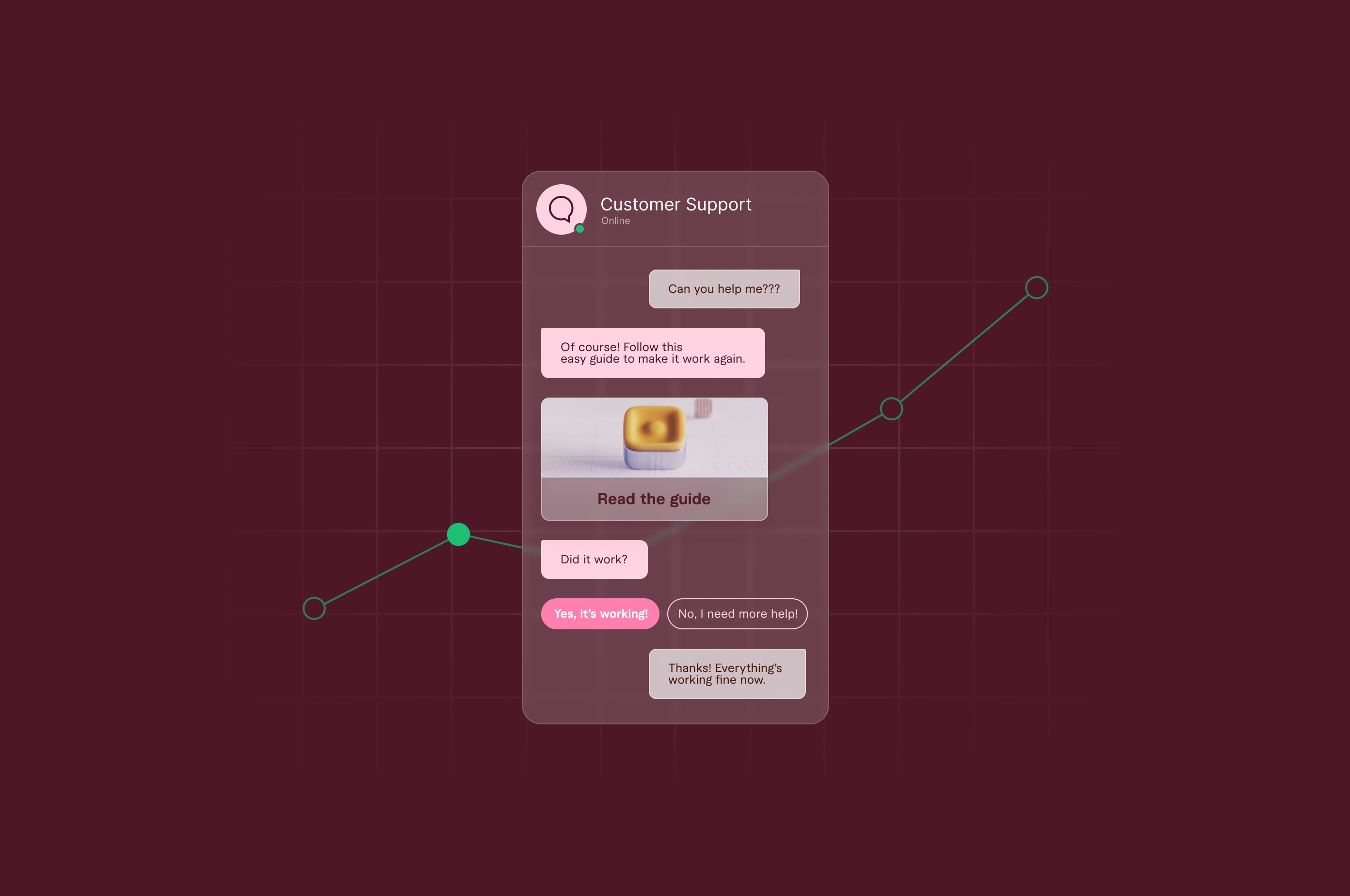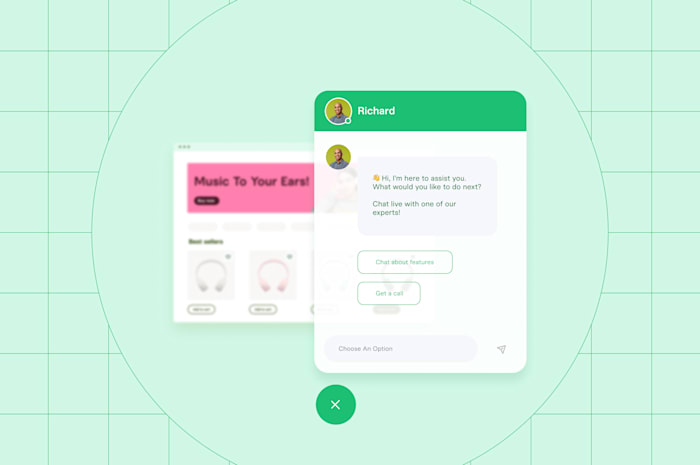Chatbot for Business: Steps, Expert Tips, & Examples
Chatbots can help businesses improve customer service, lead generation, and more. Learn how to use a chatbot to deliver positive experiences and boost brand value for your business.
 March 8, 2024
March 8, 2024 8 minute reading
8 minute reading
Customers today want to self-serve anywhere, anytime.
And they expect quick, simple experiences—and real-time responses—no “hold please” and no callbacks (unless they want to). Make them wait, and you risk losing them forever.
Meeting those expectations may seem almost unreachable, especially for small businesses. But there’s a way out: chatbots.
Chatbots let you interact with customers and provide automated support around the clock across multiple channels. Consumers love them, too. In fact, 40% of customers say they’re interested in brand chatbot experiences. So, there’s no better time to implement them in your business.
This guide shares everything you need to know about chatbots for business and how to incorporate them into your strategy and workflows.
Find a chatbot developer on Fiverr
What is a chatbot for business?
A chatbot is a computer program or application that simulates human conversations and can automate tasks.
Depending on your business needs, you can implement either of the two main types of chatbots:
Rule-based: Rely on a predefined script or set of rules to respond to customer requests and basic questions in tasks with clear, well-defined processes. They’re rigid, with little capacity or flexibility to handle unexpected inputs.
AI chatbots: Use machine learning (ML), natural language processing (NLP), and artificial intelligence (AI) models to understand sentence structure and intent, process the information, and deliver relevant answers based on existing data. These chatbots progressively learn to respond to questions instead of using predetermined scripts and outcomes.
Use the rule-based type if you have well-defined, repetitive tasks to delegate. AI-powered chatbots are ideal for dynamic tasks and more complex customer interactions that involve understanding natural language and context.
“Thanks to AI bots, customers express delight as they do not get stuck in endless loops,” says Ashu Dubey is the Co-Founder & CEO of Gleen—a generative AI chatbot solution. “Because the AI has a more conversational approach, customers don't feel as if they are just being pawned off into a system, but that their issues are being addressed appropriately.”
However, you can still use both chatbots in your business to get the best of both worlds. The rule-based chatbot can serve as the first line of interaction, responding quickly to basic queries, while the AI chatbot uses the customer data it collects to deliver more context-sensitive and personalized customer experiences.
What are the benefits of using a chatbot for business?
Aside from automating responses, here are some key benefits of chatbots for your business.
Reduce costs
There’s a good reason global spend on chatbots will increase by 470% over the next five years: they’re cost-effective and efficient.
Chatbots work 24/7, handling volumes of simultaneous interactions. And they’re scalable—especially during a surge in customer queries or peak periods.
So, you can use chatbots to optimize different processes in your business that previously required human involvement, like collecting customer information, answering common questions, or sharing helpful resources. This can reduce the need for 24/7 staffing or even reduce after-hours staffing costs.
Improve customer care
Chatbots’ round-the-clock availability and service improve your response times, ensuring customers get swift help.
These virtual assistants have access to a vast knowledge base of product information, troubleshooting guides, and frequently asked questions (FAQs). So, they’ll offer quick, consistent, and accurate responses to customer queries and information requests, which improves customer satisfaction and loyalty.
Your human agents will be free to focus on more complex issues that require their judgment, expertise, and experience, resulting in:
Faster responses
Shorter average handling time (AHT) for customer service interactions
Higher issue resolution rates
Convert website traffic
Chatbots can nudge high-intent leads to take desired actions through conversations by asking simple questions or offering help.
For example, Gong—a revenue intelligence platform—uses its Brunobot chatbot to greet website visitors and offer helpful options and resources.
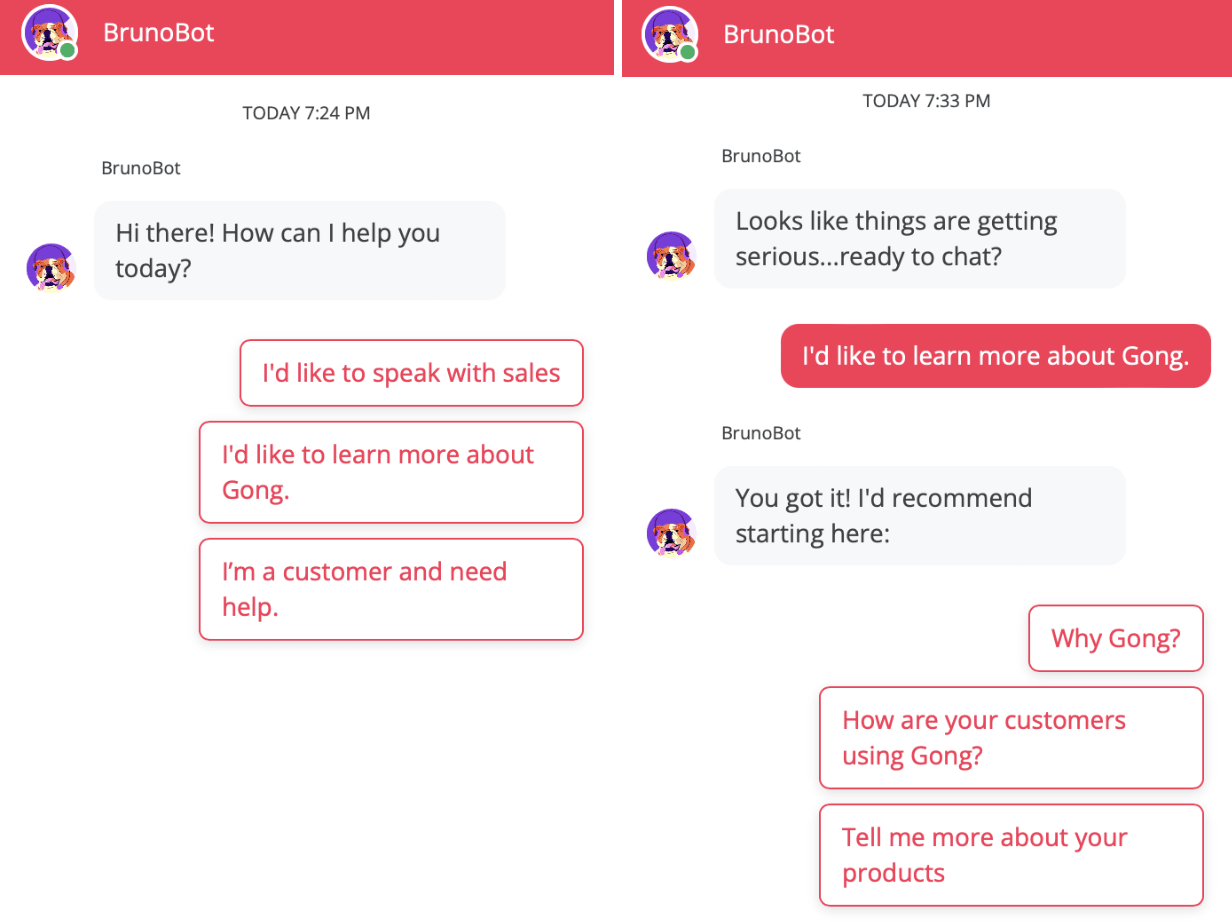
Source: Gong
If a visitor selects the option to learn more about Gong’s platform, the chatbot offers additional options to get more information about the product, how Gong customers use it, and other available solutions—in the same conversation.
Chatbots can also guide leads through sign-up processes, answer any lingering queries, and start the sales conversation.
Omnichannel engagement
Whether it’s a website, social media, mobile app, or messaging platform, chatbots can communicate seamlessly across multiple channels. This streamlines your support process, ensuring you offer a consistent and accessible user experience wherever your customers contact you.
Break down language barriers
Chatbots can communicate in multiple languages, breaking down existing language barriers.
English is the default language for many chatbots, but with today’s translation and AI technology, it’s possible to conquer language barriers customers face.
For example, if you run a retail brand in parts of Europe and North America, adding a multilingual chatbot ensures your customers get support in their preferred language, regardless of location. A customer can ask a question in Spanish, and the chatbot will deliver support in Spanish, further enhancing your connection with customers.
Florence—a Facebook Messenger chatbot—offers advice on mental health and healthy living in Arabic, Chinese, Russian, Spanish, Hindi, and French.
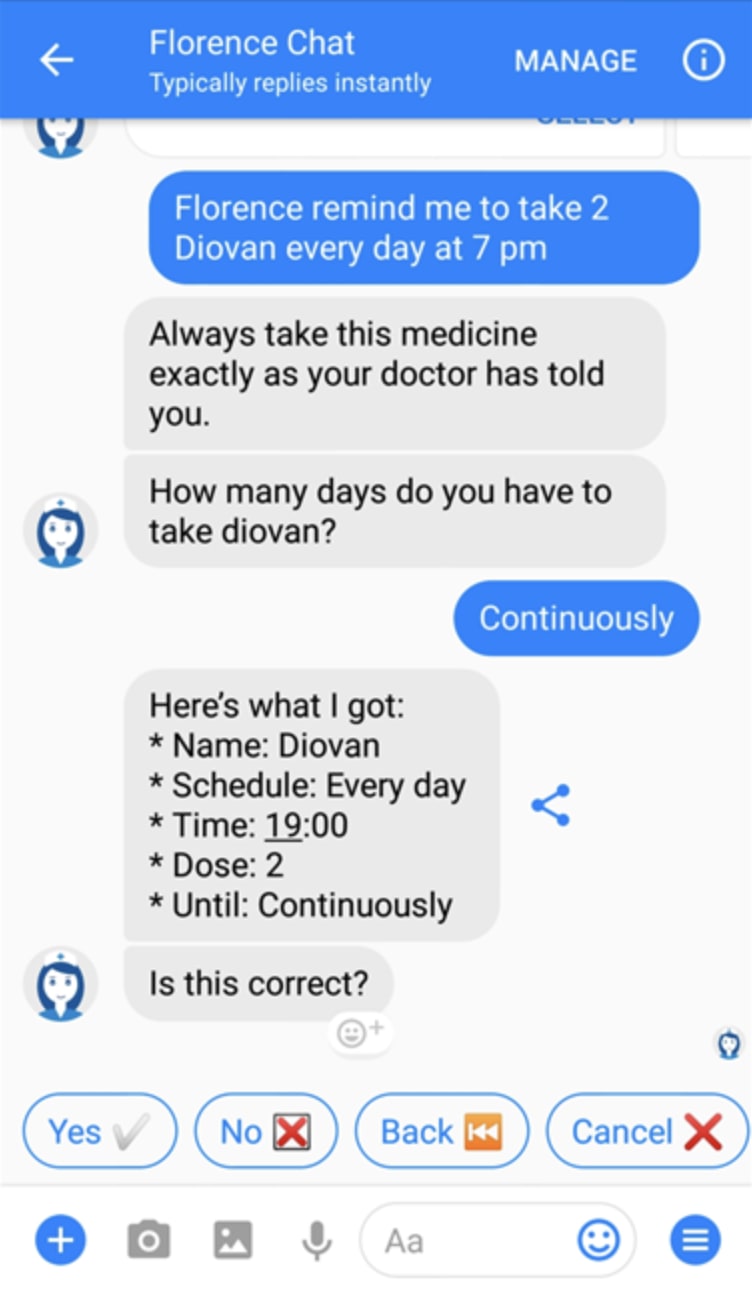
Source: Florence
Multilingual capabilities allow you to expand your reach into new/untapped markets, unlocking growth and expansion opportunities.
Gain valuable insights
As chatbots interact with potential customers, they gather valuable data and insights, which you can use to:
Understand customers’ pain points, needs, behaviors, and preferences
Identify areas for improvement
Personalize marketing strategies
Create more helpful products and content
Nurture leads and close deals faster
Take Rebag, for example. The company’s marketing chatbot uses conversational AI to collect visitors’ details, like their name, phone number, and email address.
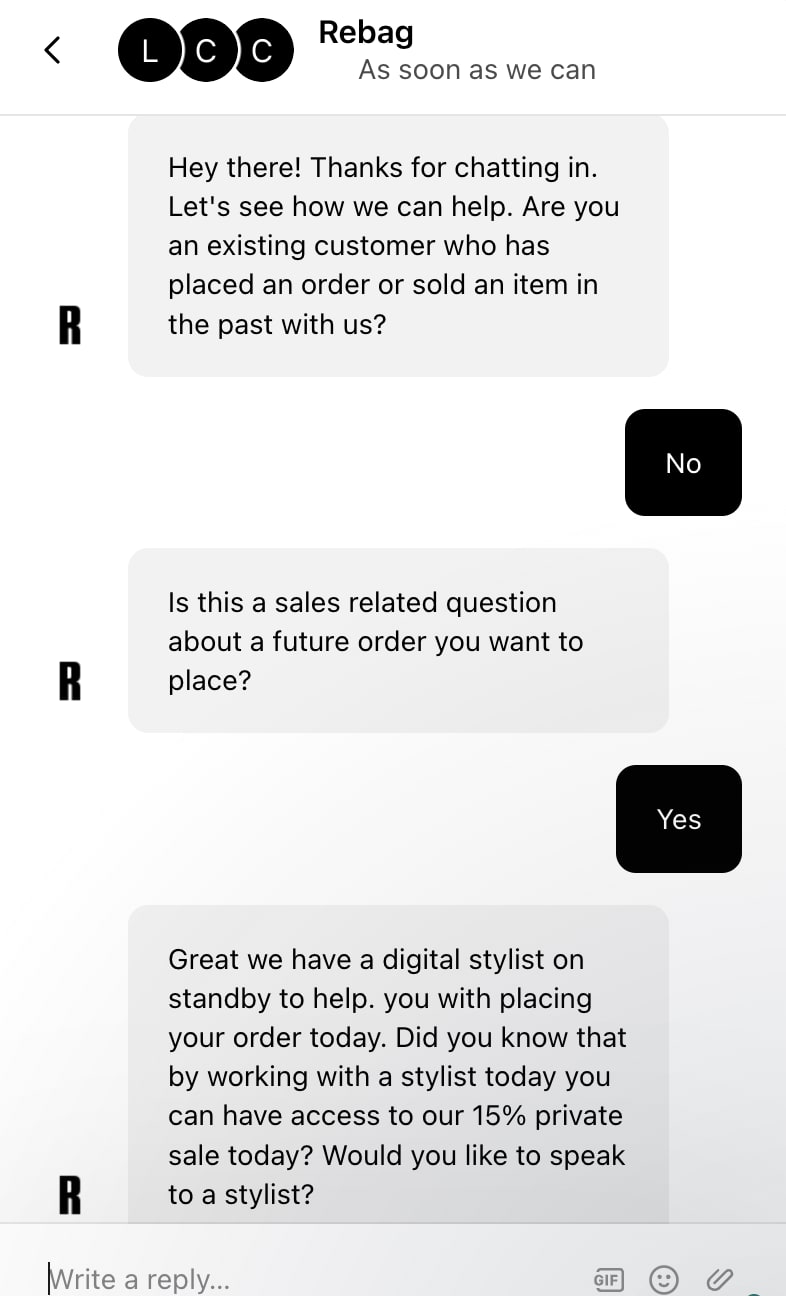
Source: Rebag
Then, it responds to customers’ queries in real-time with the relevant information, or directs them to the next available digital stylist. The chatbot, Rebag:
Nurtures leads through the sales funnel and customer journey
Offers stellar customer support
Drives customer engagement and sales
By implementing a chatbot for business, you can gather conversational data—like the options the visitor chose in the chatbot sequence, their questions, and products they’re interested in—and get insights into each lead. Chatbots can also zero in on each lead’s needs to qualify them faster.
But what are innovative examples of chatbots in action? Let’s explore a few use cases that show the breadth of possibilities for your team and business.
What are the use cases for chatbots for business?
Chatbots can benefit any business and industry, but there are a few standout use cases. Let’s look at them.
Retail
Chatbots are indispensable in the retail sector as they alter how customers shop and revolutionize customer engagement.
For example, Ole & Steen—a Denmark-based bakery—uses its chatbot to provide customers with information about its products, payment options, and loyalty club.
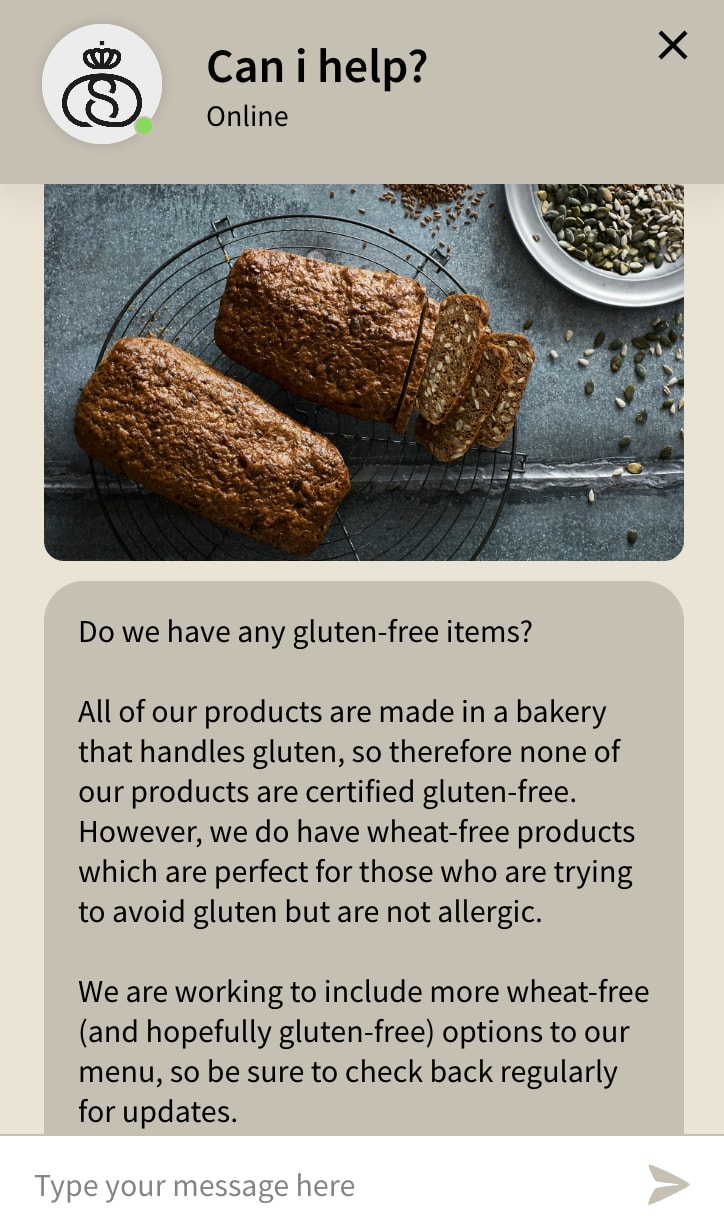
Source: Ole & Steen
Specifically, retailers can use chatbots to:
Offer real-time support on product, shipping, and return information, which increases customer happiness and encourages repeat business
Provide a personalized touch and recommendations based on user behavior, preferences, and past purchases
Update customers on their order status through automated notifications and updates
Act as a virtual shopping assistant at every stage of the purchase process
Simplify the checkout process by offering support with payment alternatives, applying coupon codes/discounts, and handling technical issues
Insurance
The insurance industry handles volumes of customer data, thanks to the countless policy and claims documents insurers receive every day.
It’s no wonder companies like Humana Insurance use chatbots to manage these volumes and other administrative tasks for their customers, agents, and medical providers.
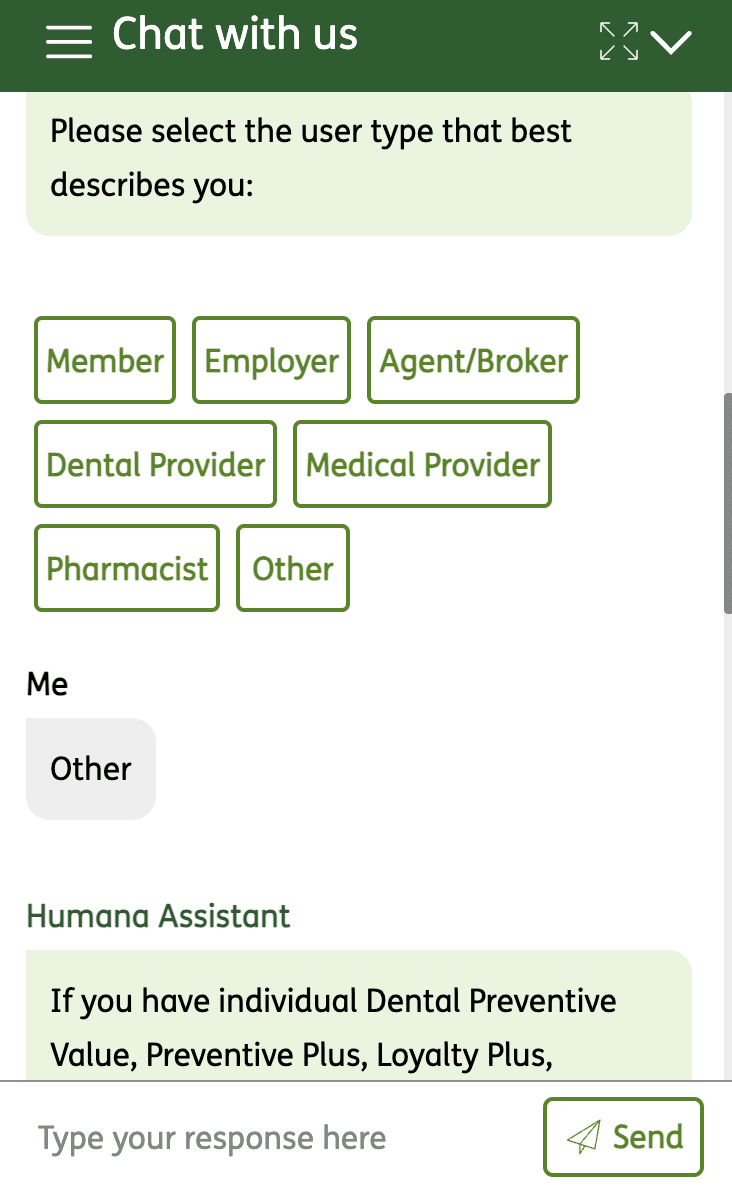
Source: Humana
Chatbots can dramatically transform the insurance industry by:
Expediting insurance policy applications
Streamlining generating insurance quotes and offering insurance policy coverage guidance
Starting and monitoring insurance claims processing
Offering automated reminders about policy changes, upcoming renewals, and other relevant updates
Handling risk assessment and offering insightful, personalized recommendations and advice
Hospitality
Hotels and restaurants can implement chatbots to elevate the customer experience to:
Streamline order processing and customization
Manage room reservations and table bookings
Simplify the check-in process
Provide individualized menu recommendations
Assist with takeaway and delivery services
Collect customer feedback
Notify customers of discounts, promotions, and loyalty programs
Healthcare
Players in the healthcare industry are also revolutionizing patient care using chatbots.
Ochsner Health, for example, uses its chatbot to maintain provider information that can encourage its customers to seek care online. The chatbot offers support, like finding a doctor or location, scheduling appointments, or paying bills. It also connects users to live agents for further assistance.
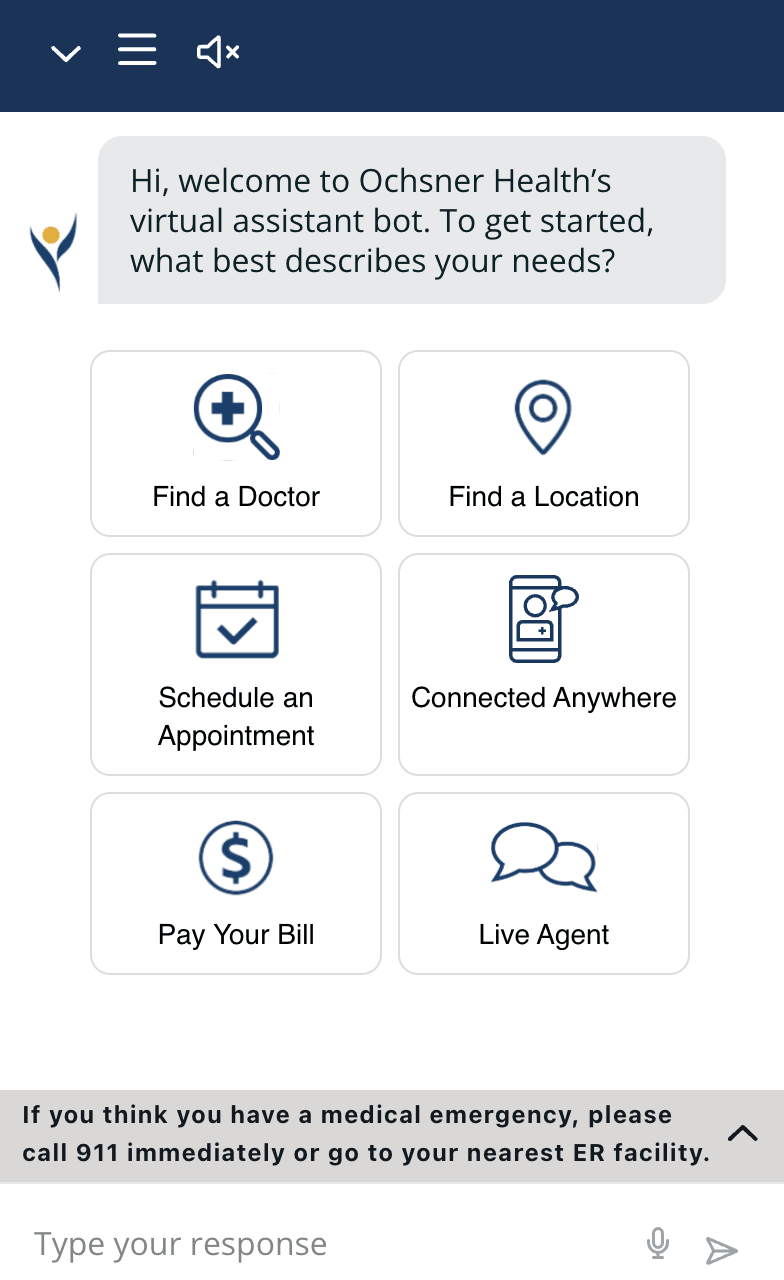
Source: Ochsner Health
Healthcare chatbots are useful in tasks, such as:
Making appointments
Sending out timely, customized medication reminders
Conducting initial symptom assessments
Offering health recommendations and reliable health information
Expanding availability of healthcare services by enabling telehealth and remote monitoring
Banking and financial services
Financial service providers have also joined the chatbot bandwagon.
For example, JPMorgan Chase & Co. is reportedly developing a ChatGPT-like AI advisor to select customer investments. Similarly, Bank of America’s Erica chatbot helps bankers build customer profiles and offers product recommendations to their clients.
Some common banking chatbot use cases include:
Handling standard inquiries and delivering prompt responses
Onboarding new customers
Enabling money transfers
Offering customer-focused service on accounts, payments, and banking products
Providing account information, transaction histories, and security updates
Other notable use cases for chatbots are for the government and public sector, ecommerce, and real estate.
Next, let’s review how you can implement a chatbot for business.
How to create a chatbot for business
Depending on your needs and budget, you can create a chatbot for business in two ways: use a chatbot builder or hire a chatbot development expert.
Use a chatbot builder
Chatbot building platforms, like ManyChat, Tidio, and Chatfuel help you create a computer program or application your website visitors, prospects, or customers can converse with.
With these no-code tools, you can drag and drop predefined elements to design and launch a chatbot. Plus, you can use the platform’s pre-made templates to customize your chatbot’s flow, showing how it should respond to questions or direct users to your sales team or other channel.
Hire a chatbot specialist
Chatbot platforms are ideal if you lack technical expertise and want a simple chatbot for your business. However, some platforms may limit your chatbot’s capabilities, unless you build custom integrations and features.
The most effective option is to hire a chatbot specialist to build your chatbot because it:
Offers total control over your chatbot
Lets you customize your chatbot to serve your customers’ needs
Ensures your chatbot is powered to solve complex problems
Allows you to integrate the chatbot with any platform you want
Not sure where to find and hire chatbot specialists? Fiverr can help. Our digital marketplace can connect you to talented chatbot development experts, AI chatbot developers, ChatGPT application developers, and UX designers who can build chatbots tailored to your needs and budget.
Best practices for using a chatbot for business
To get the most out of your chatbot for business, check out these best practices:
Give your chatbot a personality and customize it to match your brand. But don’t pretend it’s a human, or visitors will expect it to respond like one.
Ensure every chatbot conversation opens with a value statement that offers context before asking users questions.
Provide personalized experiences for each user. Not everyone comes on your site to do the same thing, so send them on different paths based on their needs.
Keep chatbot interactions simple and precise, by providing exactly what the visitor wants.
Conclude chatbot interactions with a relevant call to action (CTA) to drive actionable outcomes. Examples of CTAs include sign up for our newsletter, book a demo, or upgrade your plan.
Conduct regular A/B tests for your chatbot to continuously train and improve your chatbot, increase engagement levels, and boost conversion rates.
Always provide an option for visitors to chat with any of your sales reps or support team members. Chatbots help leads get what they need faster, but a human fallback option allows people to express themselves fully.
Choose a chatbot solution with the functionality (templates, analytics, powerful algorithms, APIs, security, etc.) to incorporate in your chatbot business strategy, accomplish your goals, and assist with future expansion.
Bring in the bots
The promise of chatbots is attractive.
Ready to implement them into your business to speed up the purchase process and deliver immediate value? Then you’ll need the right team to make things work.
Fiverr’s digital marketplace makes talent staffing a breeze. The platform is home to thousands of top-rated chatbot specialists with the skills to build effective AI. Plus, you get a single dashboard to manage all your projects, freelancers, and payments—for free!
Sign up for Fiverr to source chatbot development talent for your project today.

